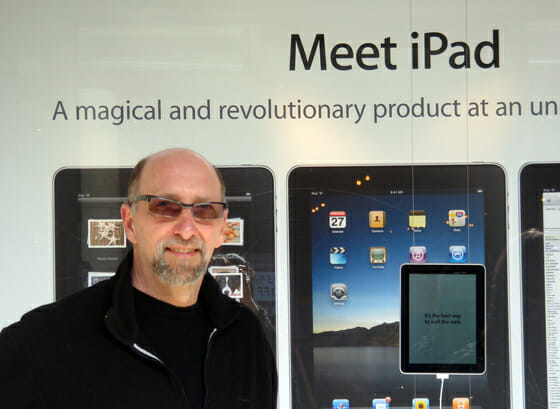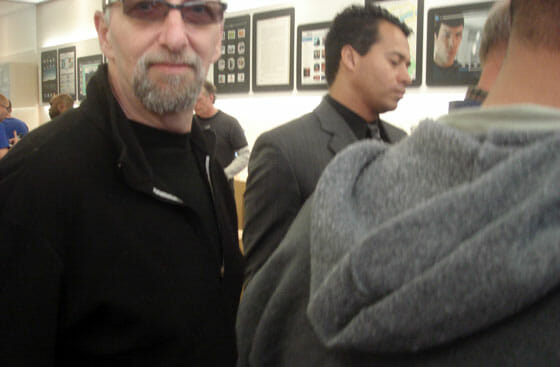 In the later 1980s or early 1990s Citibank in New York, where we were living at the time, redid all their Manhattan branches, ripped out the old ATMs and installed new ones with full color, touchscreen interfaces. They were very easy to use. Every other ATM used a green or gray character-mode interface with buttons and keypads. The difference was startling. Here you could just point at what you wanted to do.
In the later 1980s or early 1990s Citibank in New York, where we were living at the time, redid all their Manhattan branches, ripped out the old ATMs and installed new ones with full color, touchscreen interfaces. They were very easy to use. Every other ATM used a green or gray character-mode interface with buttons and keypads. The difference was startling. Here you could just point at what you wanted to do.
Over the years I was surprised that no one else followed Citibank’s lead. Even Bank of America, the largest bank in the country, and where we banked after coming to California, used the old character mode screens. Eventually they pasted a color JPG on top, but it was still 1985 when you logged in.
Despite the efforts that Tom Cruise had made in Minority Report, it wasn’t until the iPhone and iPod Touch arrived that the touchscreen really caught on. But wait, I want to go back even further, and I promise it’s worth it.
The Primitive and The Promise
When you look at really elegant user interfaces, the kind where the technology behind the interface is almost completely invisible, subsumed into the device itself, you understand which devices are far away from that ideal. Compared to the Citibank touchscreen ATM, every other ATM was primitive. To watch TV, you turn it on, tune to the station you want to watch. It’s so simple and direct there doesn’t seem to be an interface at all. But we just don’t see it.
This is why I’ve been complaining for many years that no matter how wonderful our computers, no matter how big the hard drives, how precise the monitors, that computing itself was still in a primitive phase, and that computer manufacturers had turned us all into hobbyists. Why else on earth would anyone who doesn’t work in technology need to know about things like USB, RAM, Ethernet cables, refresh rates, bus speeds, serial ports and MODEMs? Why has the underside of every desk I’ve sat at for the last 20 years looked like a spaghetti factory running off power strips?
Configuring ports, formatting hard drives, stepping through series of dialog boxes filling in SMTP server specifications are things that hobbyists do. Nobody else wants to do this stuff, but we’ve had no choice if we want to enjoy the fruits of the digital age.
All along there’s been a dream that we would eventually combine all the major computing and communication functions in one, convergent device, that each citizen of the new digital world would have one of these devices, and that they would have reached the level of technical sophistication where the device served the wishes of the owner, and not the other way around.
Back to the Future, Once Again
Yesterday was iPad launch day, and it was impossible to ignore. Everyone is prognosticating, reviews started to appear, “breakdown” photos bubbled up and I’m sure Mashable had some record traffic.
We headed down to the Apple Store in the afternoon, just in time to see the mall security guards loading up the rope barriers used to contain the eager crowd at the beginning of the day. Although it was crowded, busy and heady with euphoria, you could move around, and I only had to wait about 5 minutes to get my hands on one of the demo machines on the iPad table near the front window.

Here you can see the photo Jill snapped while a fellow in a blue t-shirt was informing her photos were NOT ALLOWED.
The iPad was completely unsurprising. It seemed like a cross between my iPhone and the iMac I work on every day. It had the glossy black sleek and polished look of the iMac, with the iPhone’s app pages, flick-ability, and touchscreen interface. It’s heavy for its size, but not unpleasantly so. With my hand on the underside I could feel the fans kick in, with a little vibration, giving it a feeling of being animated.
The screen of the iPad is brilliant and clear just like an iMac, and the responsiveness of the computer is noticeable. The thing is fast. Since I didn’t have much time I decided to focus on the iBookstore and iBook reader and the word processing/layout program, Pages.
The iBookstore was every bit as colorful and smooth to operate as the video tour had promised. Tap, and a book opens up though a quick animation. Flick, and the pages turn quickly in the dimensional book graphic. Turn the iPad sideways and the “page” becomes a “spread,” although the iPad typography fails at this task, since it doesn’t resize the type, leaving huge spaces in the lines. But the full page book reader is very servicable for reading, and far more interesting to look at than the eInk screens used by Kindle and other eReaders. The iBook reader still had the same fonts we saw in the launch videos back in January.
What About those iPad Fonts?
I tried out Pages, Apple’s word precessing and page layout program. Here you can get acess to a much larger set of iPad fonts. According to developer Michael Critz, the iPad fonts include:
Academy Engraved
American Typewriter
Apple Gothic
Arial
Arial Hebrew
Arial Rounded
Baskerville
Bodoni 72
Bodoni 72 Oldstyle
Bodoni 72 smallcaps
Bodoni Ornaments
Bradley Hand
Chalkduster
Cochin
Copperplate
Courier
Courier New
DB LCD Temp
Didot
Futura
Geeza Pro
Georgia
Gill Sans
Heiti J
Heiti K
Heiti SC
Heiti TC
Helvetica
Helvetica Neue
Hiragino Mincho Pro
HiraKaku Pro
Hoefler Text
Marker Felt
Optima
Palatino
Papyrus
Party
Snell Roundhand
Thonburyi
Times New Roman
Trebuchet
Verdana
Zapf Dingbats
Zapfino
This is not a very exciting, or even competent list of fonts and, I’m afraid, it’s obvious that no one at Apple read my post about the Apple iPad fonts we want. Oh well.
Pages, however, is a slick and user-friendly program. Obviously, I wasn’t able to see many of its features, but I went into the page setup screen and experimented with the settings offered. One thing I was quite impressed with was the way the program used the touchscreen interface for tasks we would usually do through typing into dialog boxes.
Setting the margins, for example, only required me to put a finger on the margin line and drag it one way or the other. A helpful box popped up showing the size of the margins as I adjusted them in real time.
What’s the Verdict?
I can’t pretend my few minutes with the iPad amounts to enough experience to say anything very meaningful about the device, and I plan to return to the store to spend more time with it. Although Jill encouraged me to buy one for TheBookDesigner.com, I think I’ll wait. I have a natural resistance to early versions of radically new hardware, and a patient nature.
But the iPad seemed to draw a bright line between what has come before and what computers will eventually be. It fulfills—to some extent—the promise of portability, convergence, and transparency in the user interface that computing has long held out as an ideal. The experience of holding and using the iPad “hits a pleasure spot you didn’t know you had,” in the words of an editor from BoingBoing who showed the device on the Rachel Maddow show.
Even more, it represents the first clear example of a device that works for you rather than making you into a technical hobbyist. It seems so natural to reach out and manipulate pages, guides, photos, music files and media controls you wonder why we need all the other interface aids. When you need to type something, it pops up a keyboard, then puts it away when you’re finished. When you flip it over, it reorients to you. In every sense that I can see, it’s a computer for you to use and enjoy, not a device that makes you into its servant.
This is the most radical thing about the iPad. I was unprepared for just how mesmerizing, how magnetic the tablet is, how touching the screen to control it made it into a tactile experience, drawing you into the interaction in a more personal, almost intimate way, than ever before. People will become very attached to the iPad. It fulfills the promise of the touchscreen interface, showing a clear direction for digital devices of the future.
We can’t say whether the iPad will succeed commercially or not, although I bet it will. But I think we can say we’ve seen the future of computing, and that future will look a lot like the iPad does today.
Takeaway: In person the Apple iPad breaks entirely new ground in the experience of computing, and has the potential to radically change the technology we use everyday. It is an epochal change that marks a clear division between the past and the future of computing.


